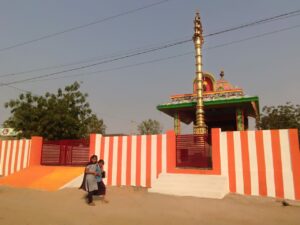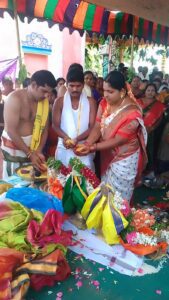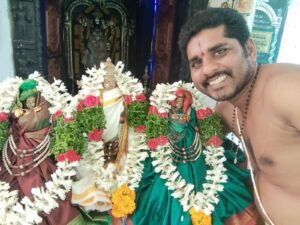SSF pracharaks visit every nook and corner of the state to conduct Hindu rituals, and motivate converts to return to the Hindu fold.

A homam being conducted by SSF pracharaks and volunteers to bring back converts back into Hindu fold (Supplied)
A silent, slow, and steady movement is on in Andhra Pradesh’s hinterlands to “protect the Sanatana dharma”.
Spearheaded by the Vijayawada-based Samarasata Sewa Foundation (SSF), the movement has the blessings of the Tirumala Tirupati Devasthanam (TTD), an independent trust which manages temples in Andhra Pradesh.
Hundreds of SSF-trained dharma pracharaks, somewhat like evangelists, are at the forefront of the movement, “spreading awareness” on Sanatana dharma — the absolute set of duties or religiously ordained practices incumbent upon all Hindus, regardless of class or caste differences.
The pracharaks visit every household, specifically of the marginalised commnities, to spread the message of dharma, conduct Hindu rituals and encourage those who have converted to Christianity to return to the Hindu fold.
The SSF, floated by former IAS officer PVRK Prasad in 2015, has also constructed at least 502 temples in the residential colonies of Scheduled Castes (SCs), Scheduled Tribes (STs), and fishermen.
Besides building temples and distributing the Bhagavat Gita, the SSC has also picked up local youths from marginalised communities to become archakas — or priests.
TTD has trained around 500 people from the SC, ST, and fishermen communities to conduct Hindu rituals, nitya puja, vratas, katanas, and other shodasa pujas.
A vast network of pracharaks helped SSF to roll out a “ghar wapsi” — or returning home — programme in Andhra Pradesh’s 520 mandals, re-inducting 23,000 converts into the Hindu fold, according to the organisation.
“The first Dharmika Sadassu (conclave) held on 2 December, 2015, at the Asthana Mandapa of Tirumala Sri Balaji Temple, resolved to reignite the Hindu dharma from the village level,” SSF founder secretary, Pakhala Trinadh told South First.
“It was also decided that all Hindu families should be a part of this activity, and the conclave pledged total support to Samarasata Sewa Foundation, which has been working full-time,” he explained.
“The conclave opined that religious conversions have been leading the nation to fragmentation and that a gulf has been created between those who had converted and those who remained loyal to their faith in villages,” he said.
About 60 seers from different mathas and peethas (monastic institutions), including Jayendra Saraswathi Swami, Vijayendra Saraswathi Swami of Kanchi Peetham, Visveswara Thirdha Swami of Pejavar Peetha (Udupi), attended the conclave.
At the meeting, the religious heads resolved that conversions should be curbed to keep the society united.
“Samarasata Sewa Foundation was established to take the Hindu dharma and its values even to impecunious huts of the most interior villages scientifically and logically. The aim is to establish a Sanatana Hindu society that views all as equals without any upper and lower social classification,” Trinadh said.
Advisory bodies have been formed at the district, mandal, and village levels. Each body has a convener. They organise several events in the villages.
Village and mandal-level committees, comprising 10 members from each village, too, have been formed.
The SSF has identified and trained persons with a “burning zeal” to “protect and propagate” Hindu dharma as pracharaks.
The pracharaks are from all castes and classes. There are now sub-divisional dharma pracharaks (one for three Mandals), divisional dharma pracharaks (one for 20 mandals), zonal pracharaks (one for each zone), and one state pracharak.
After its establishment, SSF pracharaks conducted a “Dharmic survey” at 85,866 villages in 320 mandals of Andhra Pradesh’s 13 districts (13 more districts were created on 4 April, 2022), looking at the dharmic and social conditions of primarily the poor.

Lord Kodanda Rama Swamy Temple built by the SSF and TTD at Thakellapadu village of the NTR district. (Supplied)
They collected details on dharmic activities, the condition of temples, and religious conversions. The data collected now acts as the guiding light and helps Dharma pracharaks prioritise works.
“We observed that Hindu organisations don’t go to people like Christian missionaries, specifically to those from the marginalised sections. Due to this drawback, they get attracted to other faiths,” Trinadh continued.
“In many cases, they want to return to the Hindu fold but are clueless about how to do so. They are apprehensive about being welcomed back,” he said.
“We assure them that they are welcome and provide moral support. Our pracharaks in the field gather information on factors that had led them to convert and if they want to come back. If someone wants to come back we facilitate it, Trinadh explained.
“Some of the converted persons quietly start visiting temples. A few of them face a dilemma since they have been baptised. We conduct a special ritual called prathyeka puja in which we conduct either Satyanarayana Swamy vratam or shanti homam as a welcoming gesture,” he added.
The SSF said that it has observed that religious conversions are more in North Andhra districts, East and West Godavari, Krishna, Guntur, and Prakasam. From Nellore to the Rayalaseema districts the conversions have been relatively low.

ST priest Banavath Veerababu performing Sri Srinivasa Kalyanam in Thakkellapdu village of the NTR district. (Supplied)
Another observation was that the converted were unable to pay a 10th of their monthly income to the local church due to inflation and the Covid-triggered economic slowdown.
“The model of involving people from the weaker sections in constructing and maintaining temples and entrusting them with the archaka vidhi of helped Hinduism and Hindu leadership in winning their trust,” another SSF office-bearer told South First.
The local community’s involvement in the building and upkeep of new temples has stymied conversions to a certain extent, he added.
“The SSF volunteers have been successful in creating a feeling that these people, too, are an integral part of the Hindu community. While the general populace welcomed them, the pastors and evangelists showed some reluctance,” he further said.
“But the initial reluctance has been overcome, thanks to the local community’s active participation. People in isolated locations are awaiting the arrival of seers and swamis for guidance. Even in the most remote places see Christian missionaries. Hindu leaders, meanwhile, are confined to cities and towns,” he pointed out.
The archakas are also happy. “It is like a new identity to me. Nowadays, alongside Brahmin priests, we are also called by the general public to perform rituals at their homes,” Archaka Swamy Banavath Veerababu told South First.

ST priest Banavath Veerababu at a temple built by SSF and TTD at Thekellapadu village of NTR district
“Every day I open the temple around 6 am and conduct daily Kainkaryams to the presiding deity that will go on till around 9 to 10 am. Later in the evening, I open the temple from 6 pm to 8 pm. In the evenings we will also have several community-related programmes, besides Bala Vikas programmes for our children,” .
He was trained by the TTD and SSF in 2017 and has been discharging his duties as an archaka at the Sri Kodanda Rama Swamy Temple constructed in one of the SC/ST colonies in Takkellapadu village of the NTR district.
His training was in four phases. At the end of the training, he was also was given the Yagnopaveetham (sacred thread).
“I was involved in the temple construction. And when someone from the SSF asked if anyone was interested in taking up the priest’s job I grabbed the opportunity,” Veerababu added.
Belonging to an ST community, he did an MA in Telugu language at the Nagarjuna University. Besides doing the priest’s job, he does odd jobs in his free time.

Jul 23, 2024

Jul 23, 2024

Jul 23, 2024

Jul 23, 2024

Jul 19, 2024

Jul 19, 2024